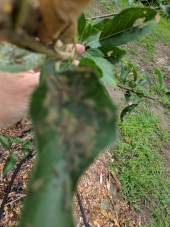Henry Jabel wrote:If they are getting very shaded out you might want to consider pruning the apple trees, if your northern hemisphere and it is not likely to freeze too badly where you are you can start it now.
Which leads to a pruning question, if course! So the main tree is probably about 30 years old, I'd guess. (We've only had the property for four years.) The tree has mostly western exposure, with some dappled afternoon light later in the afternoon once the sun clears the house. I've been pruning for about 2 years, the first year probably too aggressively. So now we have picked of 10' tall water sprouts with 2" diameters.
Reading pruning books, most recommend a multi-year regimen to keep the sprouting to a minimum. So I'm thinking about taking the top right main leader down at the fork for 2017. That branch probably has a 12-14" diameter, so I'm nervous taking it out will harm the tree.
I'd like to bring the canopy down for easier harvest, but the other issue we have is that the drip line probably has a 12' radius sticking out into the side yard. That area is the only access we have to the back yard, so we also need head clearance.
It's a lovely tree planted in a less than ideal spot. I'm hoping to keep it, rehab it to a more manageable size, and break the pest cycle. Pruning/thinning, companion planting, and possibly nematodes along with the molasses lures were my thoughts. I just don't want to kill the tree!









